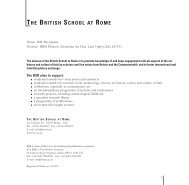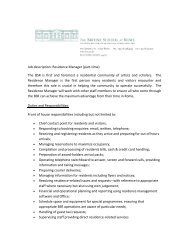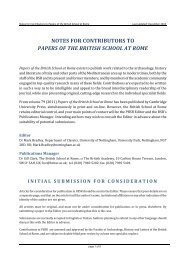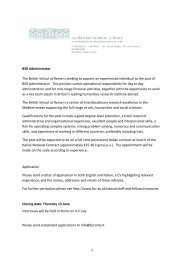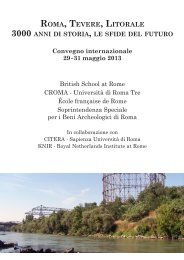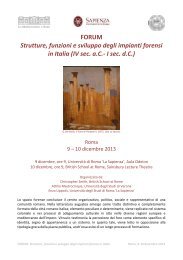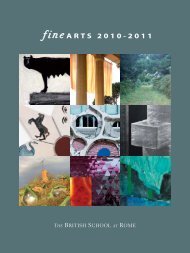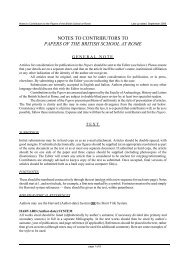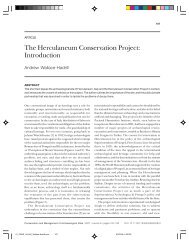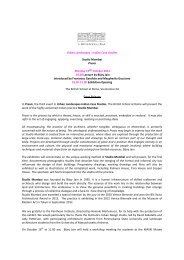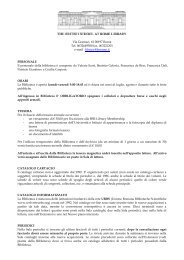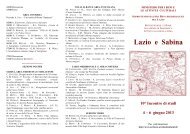Annual Report 2008-9 - The British School at Rome
Annual Report 2008-9 - The British School at Rome
Annual Report 2008-9 - The British School at Rome
You also want an ePaper? Increase the reach of your titles
YUMPU automatically turns print PDFs into web optimized ePapers that Google loves.
Above: White marble head from excav<strong>at</strong>ions <strong>at</strong> Portus<br />
Right: General view of the concentric oval walls of the<br />
Ludus <strong>at</strong> Portus<br />
ran in an east to west direction for some 250 metres and<br />
was composed of a series of parallel corridors running from<br />
north to south for its entire length. Analysis of the façade<br />
th<strong>at</strong> opened on to the channel revealed th<strong>at</strong> the building<br />
underwent major changes during the course of the Imperial<br />
period, culmin<strong>at</strong>ing in the l<strong>at</strong>er fifth century AD, when it was<br />
incorpor<strong>at</strong>ed into the defensive fortific<strong>at</strong>ion (mura<br />
costantiniane) th<strong>at</strong> encircled the port complex as a whole.<br />
Excav<strong>at</strong>ions also confirmed th<strong>at</strong> during the Severan<br />
period the channel was backfilled with sand and then<br />
covered over with a large (42 metres x 35 metres) oval-plan<br />
building. This probably can be identified as a small<br />
amphithe<strong>at</strong>re (ludus). It has important implic<strong>at</strong>ions for our<br />
understanding of the Palazzo Imperiale and adjacent<br />
buildings, given th<strong>at</strong> structures of this kind are often<br />
associ<strong>at</strong>ed with Imperial palaces <strong>at</strong> <strong>Rome</strong>, such as the early<br />
third–century AD Palazzo Sessoriano, and military<br />
complexes, such as the Castra Praetoria.<br />
A R C H A E O L O G Y<br />
In addition to this work, <strong>at</strong>tention was also directed<br />
towards further understanding l<strong>at</strong>e Imperial levels, not least<br />
including the excav<strong>at</strong>ion of a series of l<strong>at</strong>e antique burials<br />
outside the mura costantiniane. <strong>The</strong> work on the excav<strong>at</strong>ion was<br />
complemented by a programme of environmental coring by<br />
J.-P. Goiran (Lyon) in an <strong>at</strong>tempt to understand better the<br />
environmental context of the port: six cores of up to ten<br />
metres depth were taken <strong>at</strong> different points across the<br />
excav<strong>at</strong>ion and surrounding area. In addition, samples of the<br />
pine and oak were taken from cladding around the inside of<br />
the Hadrianic cistern for dendrochronological d<strong>at</strong>ing and<br />
sourcing work (carried out by S. Manning, Cornell University).<br />
<strong>The</strong> Trajanic Basin<br />
A team led by Justin Dix (N<strong>at</strong>ional Oceanographic Centre,<br />
Southampton) undertook a sub-bottom sonar survey of the<br />
Trajanic basin in order to reveal the depth and profile of the<br />
basin, and its rel<strong>at</strong>ionship with the Palazzo Imperiale. Initial<br />
23



